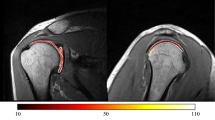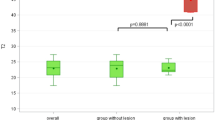Abstract
Objectives
The aim of this study was to assess the feasibility of quantifying shoulder cartilage morphology and relaxometry in a clinically feasible scan time comparing different pulse sequences and assessing their reproducibility at 3 Tesla.
Methods
Three pulse sequences were compared for morphological assessments of shoulder cartilage thickness and volume (SPGR, MERGE, FIESTA), while a combined T1ρ-T2 sequence was optimized for relaxometry measurements. The shoulders of six healthy subjects were scanned twice with repositioning, and the cartilage was segmented and quantified. The degree of agreement between the three morphological sequences was assessed using Bland-Altman plots, while the morphological and relaxometry reproducibility were assessed with root-mean-square coefficients of variation (RMS-CVs)
Results
Bland-Altman plots indicated good levels of agreement between the morphological assessments of the three sequences. The reproducibility of morphological assessments yielded RMS-CVs between 4.0 and 17.7 %. All sequences correlated highly (R > 0.9) for morphologic assessments with no statistically significant differences. For relaxometry assessments of humeral cartilage, RMS-CVs of 6.4 and 10.6 % were found for T1ρ and T2, respectively.
Conclusions
The assessment of both cartilage morphology and relaxometry is feasible in the shoulder with SPGR, humeral head, and T1ρ being the more reproducible morphological sequence, anatomic region, and quantitative sequence, respectively.
Key Points
• The thin cartilage morphology can be assessed in the shoulder in vivo.
• Non-invasive biochemical assessment of shoulder cartilage is feasible in vivo using MRI.






Similar content being viewed by others
References
Recht M, Bobic V, Burstein D et al. (2001) Magnetic resonance imaging of articular cartilage. Clin Orthop Relat Res:S379–396
Subburaj K, Souza RB, Stehling C et al (2012) Association of MR relaxation and cartilage deformation in knee osteoarthritis. J Orthop Res 30:919–926
Gold GE, Hargreaves BA, Stevens KJ, Beaulieu CF (2006) Advanced magnetic resonance imaging of articular cartilage. Orthop Clin N Am 37:331–347, vi
Kornaat PR, Koo S, Andriacchi TP, Bloem JL, Gold GE (2006) Comparison of quantitative cartilage measurements acquired on two 3.0T MRI systems from different manufacturers. J Magn Reson Imaging 23:770–773
Kornaat PR, Reeder SB, Koo S et al (2005) MR imaging of articular cartilage at 1.5T and 3.0T: comparison of SPGR and SSFP sequences. Osteoarthr Cartil 13:338–344
Bolbos R, Benoit-Cattin H, Langlois JB et al (2008) Measurement of knee cartilage thickness using MRI: a reproducibility study in a meniscectomized guinea pig model of osteoarthritis. NMR Biomed 21:366–375
Carballido-Gamio J, Bauer J, Lee KY, Krause S, Majumdar S (2005) Combined image processing techniques for characterization of MRI cartilage of the knee. Conf Proc IEEE Eng Med Biol Soc 3:3043–3046
Carballido-Gamio J, Bauer JS, Stahl R et al (2008) Inter-subject comparison of MRI knee cartilage thickness. Med Image Anal 12:120–135
Juras V, Bohndorf K, Heule R et al (2015) A comparison of multi-echo spin-echo and triple-echo steady-state T2 mapping for in vivo evaluation of articular cartilage. Eur Radiol. doi:10.1007/s00330-015-3979-6
Li X, Benjamin Ma C, Link TM et al (2007) In vivo T(1rho) and T(2) mapping of articular cartilage in osteoarthritis of the knee using 3 T MRI. Osteoarthr Cartil 15:789–797
Nozaki T, Kaneko Y, Yu HJ et al (2015) T1rho mapping of entire femoral cartilage using depth- and angle-dependent analysis. Eur Radiol. doi:10.1007/s00330-015-3988-5
Wyatt C, Kumar D, Subburaj K et al (2015) Cartilage T1rho and T2 relaxation times in patients with mild-to-moderate radiographic hip osteoarthritis. Arthritis Rheumatol 67:1548–1556
Blanco FJ (2014) Osteoarthritis year in review 2014: we need more biochemical biomarkers in qualification phase. Osteoarthr Cartil 22:2025–2032
Prasad AP, Nardo L, Schooler J, Joseph GB, Link TM (2013) T(1)rho and T(2) relaxation times predict progression of knee osteoarthritis. Osteoarthr Cartil 21:69–76
Soslowsky LJ, Flatow EL, Bigliani LU, Mow VC (1992) Articular geometry of the glenohumeral joint. Clin Orthop Relat Res:181–190
Hodler J, Loredo RA, Longo C, Trudell D, Yu JS, Resnick D (1995) Assessment of articular cartilage thickness of the humeral head: MR-anatomic correlation in cadavers. AJR Am J Roentgenol 165:615–620
Yeh LR, Kwak S, Kim YS et al (1998) Evaluation of articular cartilage thickness of the humeral head and the glenoid fossa by MR arthrography: anatomic correlation in cadavers. Skelet Radiol 27:500–504
Graichen H, Jakob J, von Eisenhart-Rothe R, Englmeier KH, Reiser M, Eckstein F (2003) Validation of cartilage volume and thickness measurements in the human shoulder with quantitative magnetic resonance imaging. Osteoarthr Cartil 11:475–482
Vanwanseele B, Eckstein F, Hadwighorst H, Knecht H, Spaepen A, Stussi E (2004) In vivo precision of quantitative shoulder cartilage measurements, and changes after spinal cord injury. Magn Reson Med 51:1026–1030
Li X, Wyatt C, Rivoire J et al (2014) Simultaneous acquisition of T1rho and T2 quantification in knee cartilage: repeatability and diurnal variation. J Magn Reson Imaging 39:1287–1293
Chen W, Takahashi A, Han E (2011) Quantitative T(1)(rho) imaging using phase cycling for B0 and B1 field inhomogeneity compensation. Magn Reson Imaging 29:608–619
Bland JM, Altman DG (1986) Statistical methods for assessing agreement between two methods of clinical measurement. Lancet 1:307–310
Glüer CC, Blake G, Blunt BA, Jergas M, Genant HK (1995) Accurate assessment of precision errors: how to measure the reproducibility of bone densitometry techniques. Osteoporos Int 5:262–270
Dixon WT, Oshinski JN, Trudeau JD, Arnold BC, Pettigrew RI (1996) Myocardial suppression in vivo by spin locking with composite pulses. Magn Reson Med 36:90–94
Acknowledgments
The authors would like to thank Dr. Xiaojuan Li and Dr. Cory Wyatt for helpful discussions. This work was supported by NIH/NIAMS R01AR057336. The scientific guarantor of this publication is Roland Krug. The authors of this manuscript declare relationships with the following companies: General Electrics. This study has received funding by NIH/NIAMS R01AR057336. No complex statistical methods were necessary for this paper. Institutional Review Board approval was obtained. Written informed consent was obtained from all subjects (patients) in this study. Methodology: experimental, performed at one institution.
Author information
Authors and Affiliations
Corresponding author
Rights and permissions
About this article
Cite this article
Nardo, L., Carballido-Gamio, J., Tang, S. et al. Quantitative assessment of morphology, T1ρ, and T2 of shoulder cartilage using MRI. Eur Radiol 26, 4656–4663 (2016). https://doi.org/10.1007/s00330-016-4322-6
Received:
Revised:
Accepted:
Published:
Issue Date:
DOI: https://doi.org/10.1007/s00330-016-4322-6




